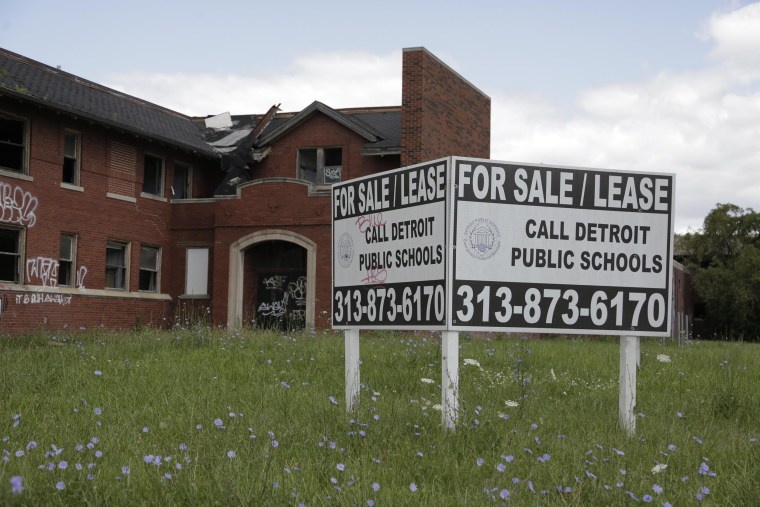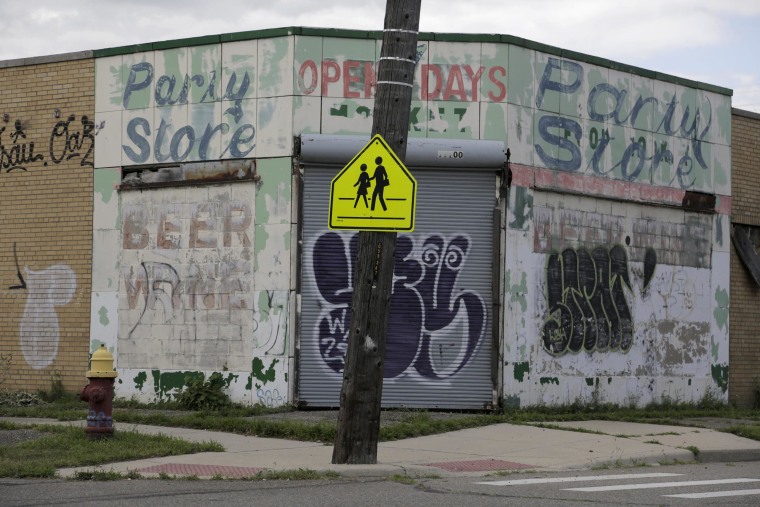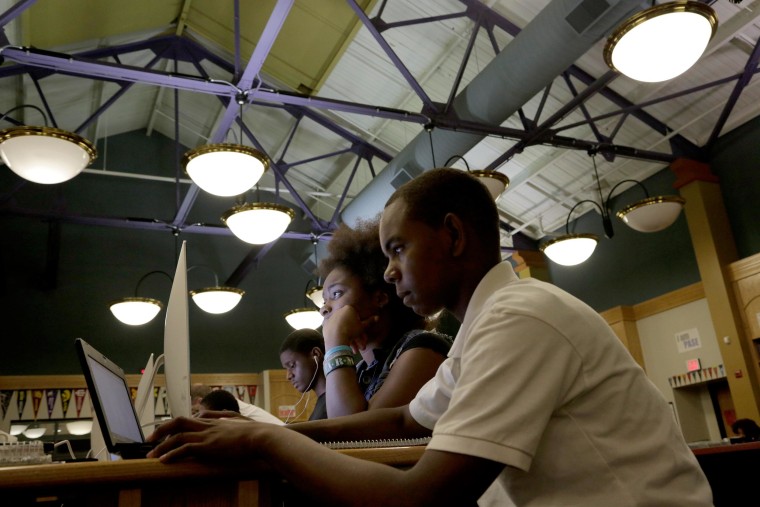DETROIT –– Many of Malik Canty’s classmates left Southeastern High School of Technology and Law last summer when they discovered the school year would no longer end in June but barrel straight through to August.
Malik, though, could see the value in the new requirement. And he thought his peers at other schools in the city, let loose for the summer while he was still in class, would have been better off sticking it out like he did.
Coming from Detroit Public Schools, the 17-year-old said, “everyone has a lot to make up.” He said he made it through his first 12 years of school reading only one book on his own, “Percy Jackson and the Titan’s Curse.” He’ll be up to two by his August graduation.
Southeastern is one of 15 failing elementary, middle and high schools in Detroit that were wrested from local control and turned over to the state to manage in the fall of 2012, where they joined a national movement to help low-income students catch up by adding class hours. More time in school –– 24 minutes more a day and 35 additional days a year –– was just one of the strategies brought in for an attempted transformation. After nearly two years, though, the results are starting to come in. Critics are arguing that adding more time, and the other strategies tried, are failing to revive Detroit’s most troubled schools.

With most students learning several years behind grade level, administrators at the state authority’s schools say extra time is desperately needed –– and not only for academics. Southeastern is using its additional daily minutes to help meet students’ social and emotional needs, which the staff views as critical for learning to occur, and this allocation of time will be set by individual advisors.
But the school has fewer students to educate now: The longer year played a major role in Southeastern losing nearly 400 students –– half its enrollment –– between the 2012-13 and 2013-14 academic years, said Jeff Maxwell, who recently resigned as principal after two years. About 200 of those students dropped out, according to state data. Others transferred elsewhere.
In a city still reeling from the recession and mortgage crisis that accelerated its decline, even critics of the state takeover agree that a radical overhaul of education is needed. Just 3 percent of Detroit’s eighth graders were proficient in math on a recent national test, for instance, and nearly a quarter of students in the public school system drop out. Yet critics question the merits of added learning time when, as they see it, quality teaching and learning isn’t happening in the first place.
“I don’t necessarily have a problem with year-round schools; I just don’t think that in and of itself is a solution,” said Chris Savage, community activist who has testified against the EAA in the state legislature and author of the Eclectablog, which has served as a watchdog to state control. “A year-round school in a sound program is a great idea.… They need to get their program in order.”
Research has shown that low-income students are disproportionately affected by summer-learning loss and have far fewer learning opportunities outside of school than their middle-class peers, but that just adding more time doesn’t necessarily result in higher achievement. Indeed, seven of the 15 state takeover schools had academic days longer than 7.5 hours before the intervention, and they still ranked among the bottom 5 percent of schools in the state.
Critics question the merits of added learning time when, as they see it, quality teaching and learning isn’t happening in the first place.
The state organization running the schools, called the Education Achievement Authority, has found itself under a barrage of criticism since its creation in 2012. While the authority said that 64 percent of students achieved at least a year’s worth of growth in reading and 68 percent did so in math, on its 2012-2013 internal assessments, opponents say the numbers are not to be trusted. An analysis of state standardized test scores by Thomas Pedroni, an associate professor at Wayne State University, found that 58.5 percent of students showed no reading progress from 2012 to 2013, and 78.3 percent failed to advance in math.

The authority has also been blasted for not properly addressing student safety, wasting money on administrator travel, and losing nearly a quarter of its students in the first year.
Teacher and administrator turnover has also been an issue. Chancellor John Covington abruptly resigned on June 17, saying he needed to care for his ailing mother, and Southeastern’s Maxwell left the week prior to take over a Chicago school. Interim replacements were immediately made for each from within the authority and weeks later Maxwell was permanently replaced with a former Detroit Public Schools school director. The authority says the resignations will not affect the program.
(Disclaimer: The state authority receives funding from the Eli Broad and Kellogg foundations, which are among the many supporters of The Hechinger Report.)
The Education Achievement Authority, as originally conceived, was tasked with developing a radically new approach to education. Grade levels were dropped as teachers were encouraged to divide students strategically and to let them collaborate in small groups. All students use an online curriculum to go through lessons at their own pace.
Computer usage starts with an hour a day in kindergarten, but high schoolers might spend most of the day on netbooks. This means that high school teachers are responsible for monitoring students’ progress and meeting with them one-on-one, rather doing whole-class lectures, which has been a tough shift for some teachers and students.
Chrystal Wilson, a spokeswoman for the state authority, says that the transformation will take time. “It’s hard getting everyone on board,” she said. “A lot of people thought [the takeover] was going to be this huge overnight success."
New interim chancellor Veronica Conforme agrees. "This program is in its infancy and certainly needs improvement," she said, adding that after conversations with parents, teachers and students, she hopes to begin using summer class time for internships and chances to recover or earn new credits, rather than having students spend nearly a full calendar year in one course.
On a recent Wednesday, a dozen Southeastern students worked through online U.S. history lessons. One was starting to plan an essay about slavery while another reviewed facts about the Seven Years War. The teacher worked with students individually at her desk.
The classroom was quiet and calm, save for one frustrated student. Then-Principal Maxwell had stopped by, and the student told him she didn’t see the point in studying African-American history and that she’d recently been kicked out of class though didn’t deserve it.
“I could do this if I had a teacher who showed she cared,” she said.
Maxwell first suggested the two of them sit down with her teacher, and then asked if she’d tried asking her classmates for help.
“We all need help,” the girl answered. “It’s messed up.”
Savage, the community activist, worries about how much time students spend teaching themselves and is particularly concerned that students seem to be guinea pigs for the online learning platform developed by a Utah-based ed tech company. “It’s never been used anywhere else,” he said.
His blog is a prominent outlet in opposition to the state takeover. He’s interviewed teachers about how constricted they feel by the online learning environment and the “dog and pony shows” some schools put on for visitors. Critics have also published op-eds in local newspapers, dumped internal documents on the web and questioned test scores.
Students who are behind need to be sold on the idea that coming to school in July and August is worth their while.
When Maxwell arrived at Southeastern as principal two years ago, the walls were covered in graffiti and ceiling tiles were ripped down. He and his staff filled four dumpsters full of trash in an initial cleaning. Getting students to follow the bells and go to class was a battle. He left a school with hallways empty and quiet during classes and generally spoke highly of the state takeover experiment just weeks before resigning.
To focus on social and emotional development during the extra daily time, as many as 35 students are assigned to a single adviser when they enter as freshmen and stick with that teacher for the next four years. The groups meet for a half hour a day. The period sometimes covers academics or functions as a study hall, but much of the time, it’s a gender-segregated place for students to have moderated group discussions about things like bullying, fighting and skin color.
A recent session of girls who would be ninth graders –– if the school still had grade levels — focused on self-esteem. The girls first were asked to fill out a survey: “Sometimes, I do not feel _______ enough,” with options like “sexy,” “smart” and “popular” below. Many girls checked off most boxes; some checked off all. During the subsequent discussion, the students unanimously agreed that going to Southeastern can contribute to low self-esteem, given the school’s reputation in the community. They began talking over each other, debating the value of Southeastern compared with Cass Technical High School, one of Detroit’s best. One student called out the definitive difference in her mind: At Cass, she said, “they go to college.”
That’s another perception the school is trying to change. Malik never thought about going to college before Southeastern was taken over, but his adviser talked him into applying. He now plans to attend community college and, despite the inadequacies in his education, hopes to eventually study medicine at the University of Michigan. To help prepare, he enrolled in a special program at Southeastern that aims to mimic college by letting students have greater control over their schedules. Each day they decide what work they want to do independently and can sign up for teacher lectures or reserve rooms for group study.
Before leaving Southeastern, Maxwell was encouraging his staff to rethink ways to use the summer school time as well, rather than just continuing classroom work as they have done the first two years. Students on track with work might be set up with internships or college summer programs. And those still behind need to be sold on the idea that coming to school in July and August is worth their while.
“It’s about framing. It’s about marketing,” Maxwell said. “We have this extra time for you to learn.”
This story was produced by The Hechinger Report, a nonprofit, nonpartisan education-news outlet affiliated with Teachers College, Columbia University.
